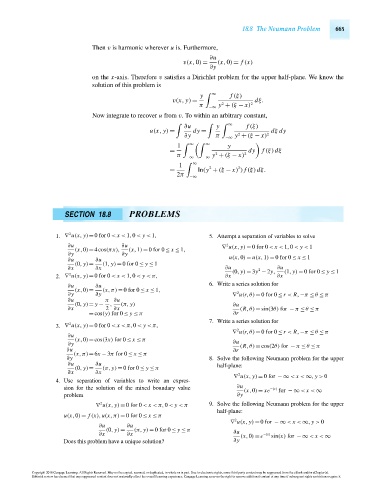Page 685 - Advanced_Engineering_Mathematics o'neil
P. 685
18.8 The Neumann Problem 665
Then v is harmonic wherever u is. Furthermore,
∂u
v(x,0) = (x,0) = f (x)
∂y
on the x-axis. Therefore v satisfies a Dirichlet problem for the upper half-plane. We know the
solution of this problem is
y ∞ f (ξ)
v(x, y) = dξ.
2
π −∞ y + (ξ − x) 2
Now integrate to recover u from v. To within an arbitrary constant,
∂u y f (ξ)
∞
u(x, y) = dy = dξ dy
2
∂y π −∞ y + (ξ − x) 2
1 ∞ ∞ y
= dy f (ξ)dξ
2
π −∞ −∞ y + (ξ − x) 2
1 ∞
2
2
= ln(y + (ξ − x) ) f (ξ)dξ.
2π
−∞
SECTION 18.8 PROBLEMS
2
1. ∇ u(x, y)= 0for0 < x < 1,0 < y < 1, 5. Attempt a separation of variables to solve
∂u ∂u ∇ u(x, y) = 0for0 < x < 1,0 < y < 1
2
(x,0)= 4cos(πx), (x,1) = 0for 0 ≤ x ≤ 1,
∂y ∂y
∂u ∂u u(x,0) = u(x,1) = 0for 0 ≤ x ≤ 1
(0, y)= (1, y) = 0for0 ≤ y ≤ 1
∂x ∂x ∂u (0, y) = 3y − 2y, ∂u (1, y) = 0for 0 ≤ y ≤ 1
2
2
2. ∇ u(x, y)= 0for0 < x < 1,0 < y <π, ∂x ∂x
∂u ∂u 6. Write a series solution for
(x,0)= (x,π) = 0for 0 ≤ x ≤ 1,
2
∂y ∂y ∇ u(r,θ) = 0for0 ≤r < R,−π ≤ θ ≤ π
∂u π ∂u
(0, y)= y − , (π, y) ∂u
∂x 2 ∂x (R,θ) = sin(3θ) for − π ≤ θ ≤ π
= cos(y) for 0 ≤ y ≤ π ∂r
7. Write a series solution for
2
3. ∇ u(x, y)= 0for0 < x <π,0 < y <π,
2
∇ u(r,θ) = 0for0 ≤r < R,−π ≤ θ ≤ π
∂u
(x,0)= cos(3x) for 0 ≤ x ≤ π
∂y ∂u (R,θ) = cos(2θ) for − π ≤ θ ≤ π
∂u ∂r
(x,π)= 6x − 3π for 0 ≤ x ≤ π
∂y 8. Solve the following Neumann problem for the upper
∂u ∂u half-plane:
(0, y)= (π, y) = 0for0 ≤ y ≤ π
∂x ∂x
2
∇ u(x, y) = 0for −∞ < x < ∞, y > 0
4. Use separation of variables to write an expres-
sion for the solution of the mixed boundary value ∂u (x,0) = xe −|x| for −∞ < x < ∞
problem ∂y
2
∇ u(x, y) = 0for0 < x <π,0 < y <π 9. Solve the following Neumann problem for the upper
half-plane:
u(x,0) = f (x),u(x,π) = 0for0 ≤ x ≤ π
2
∇ u(x, y) = 0for −∞ < x < ∞, y > 0
∂u ∂u
(0, y) = (π, y) = 0for 0 ≤ y ≤ π
∂x ∂x ∂u (x,0) = e −|x| sin(x) for −∞ < x < ∞
Does this problem have a unique solution? ∂y
Copyright 2010 Cengage Learning. All Rights Reserved. May not be copied, scanned, or duplicated, in whole or in part. Due to electronic rights, some third party content may be suppressed from the eBook and/or eChapter(s).
Editorial review has deemed that any suppressed content does not materially affect the overall learning experience. Cengage Learning reserves the right to remove additional content at any time if subsequent rights restrictions require it.
October 14, 2010 15:27 THM/NEIL Page-665 27410_18_ch18_p641-666

